How to divide the German fleet. Part II
The Tripartite Commission did not stop disputes about the division of minesweepers. Representatives of the UK insisted on their distribution after the end of the trawling in the North Sea, English Channel and the Danish Straits. The Americans agreed to keep the share of minesweepers due for this period, the Soviet delegation demanded that they allocate their share immediately, arguing that this was a difficult mine situation off the coast of the USSR. This argument is recognized as convincing.
At the same time, disagreements arose on the issue of mobilized trawlers widely used in the German navy as patrol ships and minesweepers. During the war, a large series of KFK-type ships, originally intended for the transfer of the Navy, were built according to the drawings of the trawlers. However, the British suggested that these vessels not be divided. The Soviet delegation did not agree with this, and with the support of the Americans, in the end, insisted that the trawlers built during the war should be recognized as property subject to division.
In early October, the Technical Subcommittee proceeded to the draw. The first were shared minesweepers, torpedo boats and landing barges. The ships of each of these classes divided into three groups were listed, each of which was designated by the letters X, Y and Z. The folded pieces of paper with the designation of these letters were dropped into the cap of one of the participants of the meeting, and the members of each delegation drafted lots. The Triple Commission approved the division of the ships of these classes 5 October.
Long discussions have arisen with the division of the largest of the remaining German ships. It was necessary to divide two cruisers - heavy "Prince Eugen" and light "Nuremberg", 13 destroyers and 17 destroyers. The Soviet and American representatives suggested that the destroyers and destroyers be considered equivalent ships, the light cruiser should be equated to three, and heavy to six destroyers, and on this basis, breaking the ships into groups, to draw lots. The British insisted on the transfer of "Prince Eugen" to them without a draw, arguing that the heavy losses of his fleet. They also challenged the proportions between the ships of these classes, proposing to establish the ratio of 1: 2 and 1: 4. However, Admiral Levchenko demanded precisely the toss-up, indicating that the total losses of the Soviet Union are much higher than the losses of the allies. October 29, after several intense meetings, the section of cruisers and destroyers finally took place.
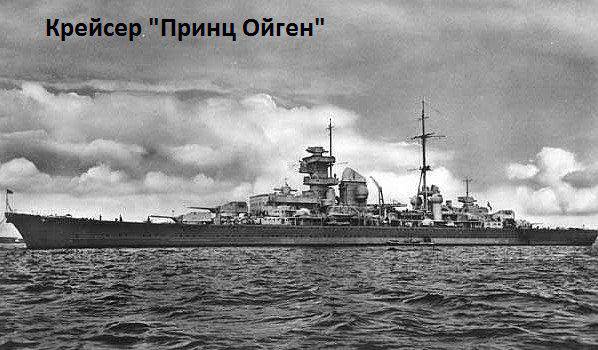
"Prince Eugen" went to the Americans, only destroyers and destroyers fell to the share of Great Britain, the Soviet Union received the cruiser "Nuremberg", 4 destroyer and 6 destroyers.
Discussions on the division of auxiliary vessels were no less acute. The British, frankly delaying the decision, did not provide lists of vessels for a long time, then made numerous amendments, refused to participate in the section. They took a particularly irreconcilable position on the issue of port ships, floating cranes and floats, insisting that they belong not to the Navy, but to the ports. As a result, the division of port ships and floating craft was conditional, with the transfer of the final decision to the governments of the three powers. As for the floats and pontoons, then, in view of the refusal of the British delegation to divide them at least conditionally, the Tripartite Commission limited itself to drawing up their common list.
When ancillary ships were divided, an interesting episode occurred, partly explaining the British persistence. The Soviet Union got the largest German tanker Nordmark. However, it turned out that, not waiting for the partition, the British had already begun to re-equip it for their own needs and, in order to keep it for themselves, the USSR transferred all the tankers it got, 9 large tugs and several dozen landing barges.
Final report The Triple Naval Commission signed December 6 1945. It includes recommendations on the division of the German fleet, port ships, boats and floats.
The Soviet Union in the division of the German fleet had 155 warships and 499 auxiliary vessels. The objections of the British did not prevent the USSR from getting more 100 ships. The share of the UK was 545, USA - 590 ships and vessels. Under the conditional section of port ships and floating craft of England, 99 and the USA got the 101 ship.
The Commission recommended its governments to approve the produced section and decide the fate of the ships and vessels, about which it was not possible to agree. It was recommended to continue the search for German ships and ships whose fate remained unknown (there were a few hundred of them) and, as they were discovered, to entrust their division to the senior naval commander of the three powers in Germany.
Ships and ships of category C were proposed to be dismantled or submerged at a depth of at least 100 m. It was also recommended to use them to provide spare parts and supplies for ships and vessels of categories A and B. This also applies to unallocated submarines. Wrecks in shallow waters and ships, if they did not interfere with navigation, were allowed not to be lifted, but it was necessary to bring them into a state of unsuitability for recovery in the future. Those states were responsible for all this, in the zone of occupation or in the territorial waters of which the indicated ships and vessels were located. Unallocated submarines should have been destroyed by 1 February 1946, and the destruction of unallocated ships should be completed by 15 in May 1947.
The ships distributed between the three powers were provided with spare parts, supplies, armaments and ammunition (the last one - two sets of peacetime) according to the norms of the German fleet from those occupation zones where they were before distribution. In case of difficulty, other countries should provide assistance with the supply. The same was true with the provision of technical documentation.
At this, the Triple Naval Commission considered its task accomplished and requested its governments to decide on its dissolution.
In the meantime, there was a transfer of distributed ships and vessels. From the Soviet side, the vice-admiral Yu.F., the commander of the Kronstadt naval defense area, led the reception, acquisition and transfer of ships. Rall. The ships transferred to the Soviet Union were concentrated in Kiel, from there they were transferred to Travemünde, where they prepared for the final transfer, and then as part of the convoys they followed either in Warnemünde (smaller) or in Swinemünde. Up to these points the transfer of the ships was carried out by German crews under the control of our officers. In Warnemünde and Swinemünde the ships received our crews, and the Germans were returning to the English zone of occupation.
The first convoy left Travemünde on October 25. The Soviet representatives constantly stated that the ships were transferred in a neglected state, they were not provided with spare parts, some auxiliary mechanisms and equipment were removed by the British. But, taking into account the approach of winter and the fact that ships destined for the USSR in the West were exploited for wear, they decided to seek their early transfer. On November 24, submarines destined to the USSR came out of England in three groups. When leaving, one of them was damaged and, at the suggestion of the British, it was replaced by another.
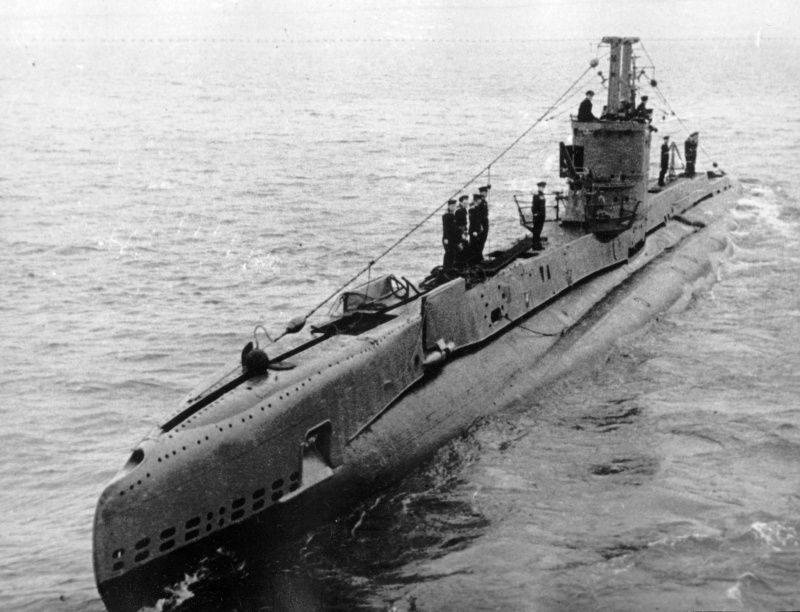
December 16 began preparations for the transfer of large surface ships, concentrated in Wilhelmshaven. December 18 Soviet sailors climbed aboard the cruiser and destroyers. The ships were in disrepair, much, as it turned out, the British had already plundered. Preparations for the transition were German workers and German teams with the help of Soviet crews under the supervision of Soviet officers. The Germans, feeling to themselves the tolerant attitude of our sailors, which was a pleasant discovery for them, helped to return to the ships much of what the British had taken. From the German crews and shipyard staff managed to pick up volunteers for service with us. With the British, despite a number of serious disagreements, the relationship remained correct. The transfer of large ships was carried out by several groups in Liepaja. It began on December 20 of the year 1945 and ended on February 6 of the year 1946.
History The activities of the Triple Naval Commission for the division of the German fleet, however, did not end there. At the initiative of the British in early February 1946, her work was resumed. The reason was the numerous errors and inaccuracies in the lists of separated ships: in some cases double counting was allowed, some ships did not fit the category according to their technical condition, etc. It was proposed to approve more than 350 amendments.
By that time, the composition of delegations had changed significantly. The Soviet side was still headed by Admiral G.I. Levchenko, the American - Vice Admiral Glassford, the British - Rear Admiral V. Perry. The newly created Technical Subcommittee, where the captain of the 2 rank N. Vizirov entered from the Soviet side. At the February 16 meeting, 1946, the Americans tended to the British proposals. The Soviet delegation, defending the disputed 35 ships, was preparing to accuse the British side, whose information formed the basis of the decisions of the Tripartite Commission, and believed that compensation should be made from its share.
The debate began. To the Commander-in-Chief of the Soviet troops in Germany, Marshal of the Soviet Union GK To Zhukov, the commander of the British Navy in Germany, Admiral Barrow, complained about the intransigence of the Soviet representatives. Zhukov proposed a compromise: to meet the British on the issue of amendments, demanding compensation from among the newly found ships and the transfer of port ships, the section of which the British continued to dispute. The compromise plan proposed by the Soviet side envisaged repeated on-site inspections, partial compensation to the Soviet Union of ships (mainly landing barges) from the British share. These proposals were generally approved by the commission and formed the basis of Addendum No. 23 adopted by 1946 in March of 1 to the Final Report of the Commission from December 6 of 1945 in December, containing the 366 amendments. At the same time, the Soviet Union lost the 2 ship, England - 41, USA - 55.
Meanwhile, in various ports all new German ships and ships, naturally, not included in the section, were found. By the end of May, 1946 had more than 100 units. The British and Americans demanded to distribute them in proportion to the losses of the parties as a result of the adoption of amendments to the Final Report, the Soviet representatives - to divide them into equal shares. After a lengthy discussion passed the Soviet proposal.
By this time, the representatives of England made new proposals. With the consent of the USSR and the USA to leave from their shares in the British zone on lease terms or in the form of temporary use a number of ships, which the British badly needed, the British government removed its objections to the division of port ships and dives. At the same time, the Soviet Union received docks in its zone of occupation as its share (which accounted for about a third of the total number of German docks). On the basis of these proposals, taking into account the Soviet requirements for the section of newly discovered ships, on May 31 of 1946, the Commission adopted Addendum No. 2 to the Final Report containing the 102 amendments. Taking into account finally separated port ships and floating craft, the USSR's share was - 790, Great Britain - 630 and the USA - 665 ships and vessels.
However, the work of the commission continued. Its final meeting in a modified composition (the American side was represented by Rear Admiral R. Shuirman, the English side was held by Captain N. Dickinson) on 28 June 1947 of the year. In the progress report, she recommended that her governments adopt Supplement No. 3 to the Final Report of December 6 on the 1945 of the year, which also contained 102 amendments.
In total, the commission held a plenary session of 31. 769 ships and ships were transferred to the Soviet Union, Great Britain - 621, USA - 665 ships and ships. In addition, the Soviet Union received 39 floats and 9 pontoons. England got 34 dock and 14 pontoons, USA - 40 docks and 15 pontoons. The Commission considered its work completed and recommended to its governments, after the approval of the final report, to dissolve it.
The fate of the former German ships and ships in the Soviet fleet was different. The cruiser "Nuremberg", known as the "Admiral Makarov", was in the fleet combat until 1957, after which it was reclassified into a training cruiser. The ship was decommissioned in the same year. Until about the mid-fifties, most destroyers and destroyers were in service. With the entry into service of new ships of domestic construction, they were withdrawn from service and re-formed into wholesale ships, floating ships, training ships.
Submarines were part of the fleet combat until the mid-fifties. Some of them have long been used as training stations. So, the former U-1064 served on the Baltic until 1974. One of the German boats in the 1957 was sunk during nuclear testing weapons (Incidentally, the cruiser Prince Eugen suffered the same fate in the US Navy). After a short service in the Navy, a significant part of the landing barges was transferred to the national economy. Most minesweepers were used for their intended purpose until the mid-second half of the 50-s. For a long time remained in the ranks of the mother ship. One of them, "Valdemar Kophamel", called "Kuban", as a floating point, lived to 1978 year. Not to mention the two training courts received by our country. These are the beautiful four-masted barges "Padua" and "Commodore Jensen", which received the names "Kruzenshtern" and "Sedov". On their account - participation in many expeditions and ocean regattas, wide international recognition.
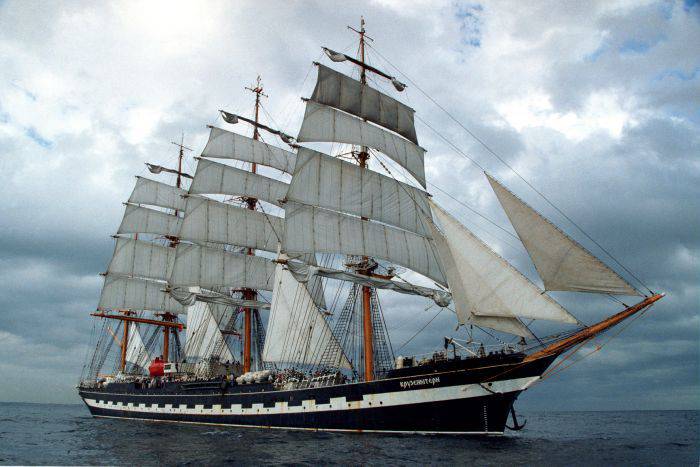
Sources:
Kuznetsov N. The course to victory. M .: Voenizdat, 1987. C. 440-443.
Sanakoev S., Tsybulevsky B. Tehran - Yalta - Potsdam. M .: International Relations, 1970. C.172-186.
Patyanin S., Morozov M., Nagirnyak V. Krigsmarine. The Navy of the Third Reich. M .: Eksmo, 2009. C. 49-50, 55, 63-64.
Komarov A. End Krigsmarine // Sea collection. 1995. No.9. C. 76-82.
Sofronov T. Japanese and German warships transferred to the Soviet Union // News of the Irkutsk State University. 2014. T.7. With 140-145.
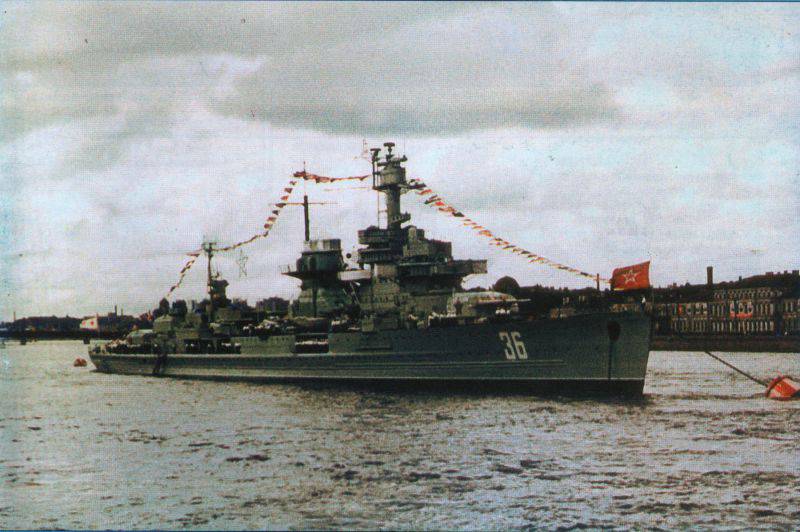
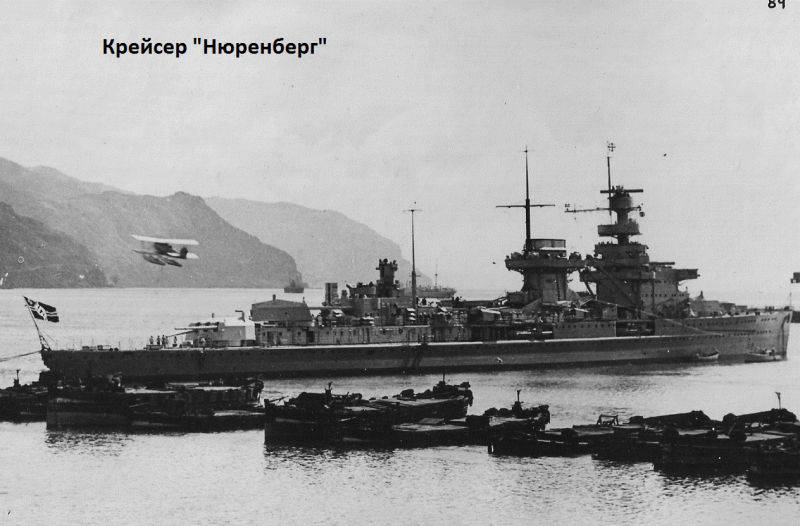
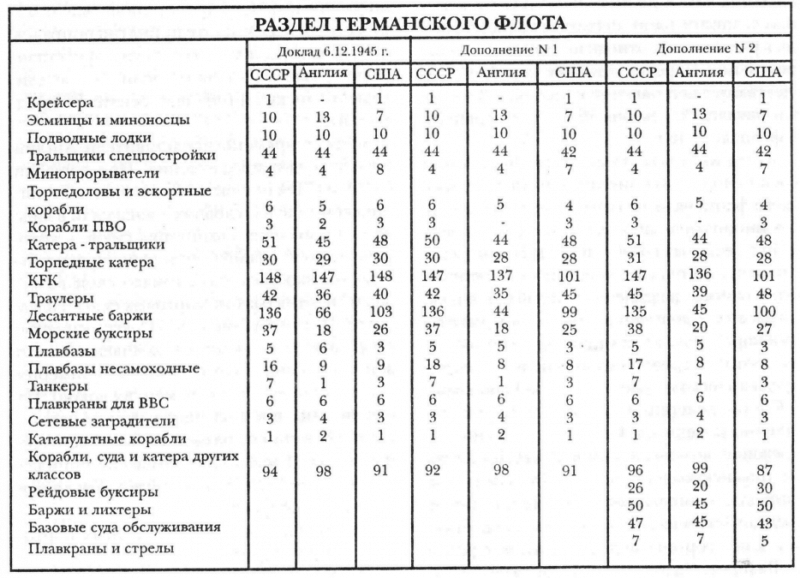
Information